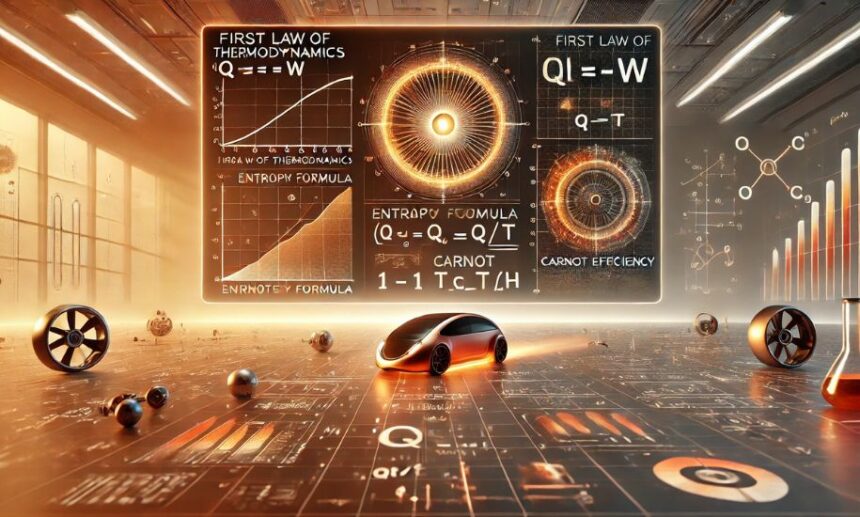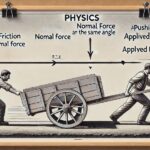Welcome to Physics Heaven, your go-to place for in-depth discussions on physics concepts. Today, we explore thermodynamics formulas, which play a fundamental role in understanding energy transformations, heat flow, and work done by a system. These formulas are crucial for engineers, physicists, and students to grasp the core principles of thermodynamics.
Thermodynamics is a branch of physics that deals with the relationships between heat, work, and energy. By using thermodynamics formulas, we can analyze energy changes in different systems and understand how processes like heating, cooling, and work generation occur.
In this article, we will explore the essential thermodynamics formulas used in different laws of thermodynamics, their significance, and their applications in real-world scenarios.
The First Law of Thermodynamics Formula
The first law of thermodynamics, also known as the law of energy conservation, states that energy cannot be created or destroyed; it only transfers from one form to another. The fundamental equation representing this law is:
Where:
- = Change in internal energy
- = Heat added to the system
- = Work done by the system
This formula explains how energy exchange occurs in a system, whether it absorbs heat or does work. It is widely applied in heat engines, refrigerators, and various thermodynamic processes.
The Second Law of Thermodynamics Formula
The second law of thermodynamics introduces the concept of entropy, which measures the disorder of a system. This law states that the entropy of an isolated system always increases over time. The mathematical representation is:
Where:
- = Change in entropy
- = Heat added or removed
- = Absolute temperature (Kelvin)
This formula is crucial in understanding the irreversibility of natural processes, such as heat flow from hot to cold bodies and the efficiency limitations of engines.
The Third Law of Thermodynamics Formula
The third law of thermodynamics states that as the temperature of a system approaches absolute zero, its entropy approaches a minimum value. This law is represented as:
This formula implies that at absolute zero, a perfectly ordered crystalline structure has zero entropy. It is essential in cryogenics and low-temperature physics.
Carnot Efficiency Formula
One of the key concepts in thermodynamics formulas is the efficiency of heat engines. The Carnot efficiency formula represents the theoretical maximum efficiency a heat engine can achieve:
Where:
- = Efficiency of the Carnot engine
- = Temperature of the cold reservoir (in Kelvin)
- = Temperature of the hot reservoir (in Kelvin)
This formula highlights the importance of temperature differences in determining engine efficiency. It is widely used in power plants and refrigeration cycles.
Work Done in an Isothermal Process
In an isothermal process, the temperature remains constant, and the work done is given by:
Where:
- = Work done
- = Number of moles of gas
- = Universal gas constant
- = Temperature in Kelvin
- = Final and initial volumes
This formula is significant in gas expansion and compression studies, especially in thermodynamic cycles.
Helmholtz and Gibbs Free Energy Formulas
To analyze the spontaneity of thermodynamic processes, we use Helmholtz free energy and Gibbs free energy formulas:
Helmholtz Free Energy:
Where:
- = Helmholtz free energy
- = Internal energy
- = Temperature
- = Entropy
Gibbs Free Energy:
Where:
- = Gibbs free energy
- = Enthalpy
- = Temperature
- = Entropy
These formulas help determine whether a reaction or process will occur spontaneously at constant temperature and pressure.
The Clausius-Clapeyron Equation
The Clausius-Clapeyron equation describes phase transitions between two states of matter, such as liquid to gas. It is given by:
Where:
- = Rate of change of pressure with temperature
- = Latent heat of transformation
- = Temperature
- = Change in volume
This equation is vital in studying vaporization, sublimation, and condensation processes.
Real-Life Applications of Thermodynamics Formulas
Thermodynamics formulas have numerous real-life applications, including:
- Power Plants: Steam engines and turbines operate based on thermodynamics formulas to generate electricity.
- Refrigeration and Air Conditioning: The working cycle of refrigerators is explained using thermodynamic principles.
- Chemical Reactions: Gibbs free energy determines the feasibility of chemical reactions.
- Space Science: Thermodynamic equations are used in studying celestial bodies and their temperature distribution.
Conclusion
Understanding thermodynamics formulas is essential for grasping the principles of energy conversion, heat transfer, and work done in various physical systems. Whether it’s the first and second laws of thermodynamics, entropy, Carnot efficiency, or Gibbs free energy, these equations shape our understanding of physics and engineering.
At Physics Heaven, we believe that mastering these formulas is key to solving complex thermodynamic problems and developing innovative technologies. Keep exploring, calculating, and applying these principles to real-world problems!








